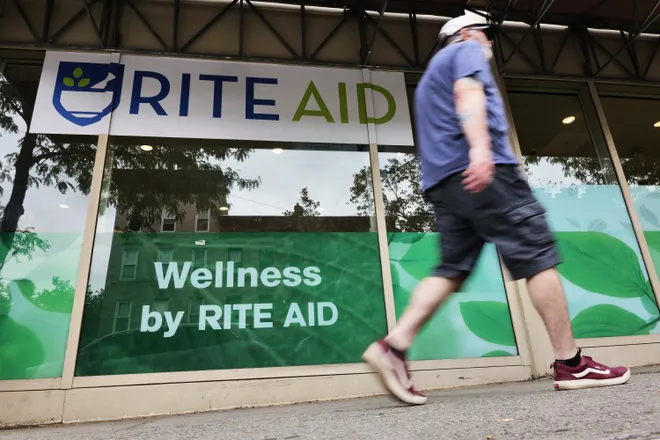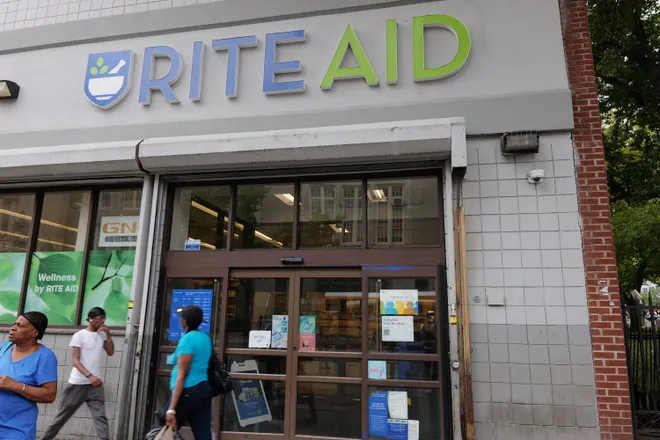Is Rite Aid at risk of bankruptcy? What a Chapter 11 filing would mean for shoppers.
Rite Aid is reportedly preparing to file for bankruptcy to address a slew of opioid lawsuits.
Philadelphia-based Rite Aid’s stock price dipped more than 50% Friday after the reports on the pending bankruptcy filing were published by The Wall Street Journal and Bloomberg, citing people familiar with the matter.The Chapter 11 filing would allow the company to restructure its more than $3 billion debt load and help it address lawsuits alleging the company filled hundreds of thousands of opioid prescriptions unlawfully.
When asked for comment on the reports, Rite Aid spokesperson Joy Errico said “we do not comment on rumors or speculation.”

What is the Rite Aid opioid scandal?
Rite Aid is facing lawsuits alleging the company helped fuel the country’s opioid epidemic by knowingly filling prescriptions for painkillers that did not meet legal requirements.
The Justice Department filed a civil lawsuit against the company earlier this year, claiming that it violated the Controlled Substances Act by repeatedly filling prescriptions that had “obvious red flags.”
The Journal reports that the company also faces more than a thousand federal lawsuits that were consolidated in Ohio and other pending litigation in state courts.
The Centers for Disease Control and Prevention says the rise in U.S. opioid overdose deaths can be tied to the uptick in opioid prescriptions starting in the 1990s. Drug overdose deaths from prescription opioids rose jumped from 3,442 in 1999 to 16,706 in 2021, according to data from the National Institute on Drug Abuse.
Why would Rite Aid file for bankruptcy?
Rite Aid has yet to agree on a settlement with the opioid plaintiffs to resolve liabilities in a potential bankruptcy filing, according to the Journal. A Chapter 11 filing would pause those lawsuits and allow the company to consolidate the claims.
“It's one-stop shopping,” said Bruce Markell, a bankruptcy law professor at Northwestern’s Pritzker School of Law. “Otherwise they would have to go into something like the multi-district litigation … with lots of different trials.”
Pharmaceutical companies including Purdue Pharma, Mallinckrodt and Endo Pharmaceuticals have already reached settlements for similar opioid-related claims in bankruptcy.
“The downside of it, obviously, is the victims who are hurt get a limited day in court if they get a day in court at all,” Markell said. “They don't get to plead their case before a jury.”

A bankruptcy filing could also impose a hard cap on Ride Aid’s aggregate liability exposure, said Ralph Brubaker, a law professor at the University of Illinois.
“Companies are becoming very aggressive in using bankruptcy to try to get that hard cap on their liability, even if the litigation is not too much to handle,” he said.
Brubaker pointed to Johnson & Johnson as a recent example. Its attempt to settle lawsuits from people claiming its talc-based powder caused cancer in bankrupcy court was dismissed by a federal judge earlier this year because the company was determined not to be in financial distress.
What does this mean for Rite Aid customers?
With more than 2,000 retail pharmacy locations across 17 states, Rite Aid is among the largest pharmacy chains in the country. But customers won’t have to worry about a potential bankruptcy filing upending their day-to-day interactions with the company.
The Chapter 11 process is “fairly invisible as far as customers are concerned,” Brubaker said. “The whole point of the Chapter 11 processes is to preserve the business operations and the value of that ongoing business to the greatest extent possible so that the payout to the claimants can be as large as possible.”
Markell said regular customers can expect their interactions with Rite Aid to continue as normal should the company file for bankruptcy.
“Rite Aid has every incentive to continue to operate and serve its customers the way it has in the past,” he said. “If I had a long-term prescription at Rite Aid, I might not change it if they filed. If Rite Aid was the closest pharmacy for where I go to get band-aids, I wouldn't stop doing that.”
Disclaimer: The copyright of this article belongs to the original author. Reposting this article is solely for the purpose of information dissemination and does not constitute any investment advice. If there is any infringement, please contact us immediately. We will make corrections or deletions as necessary. Thank you.







